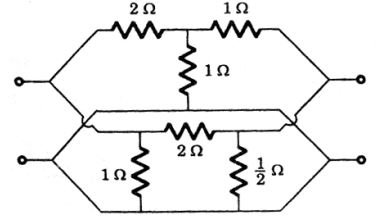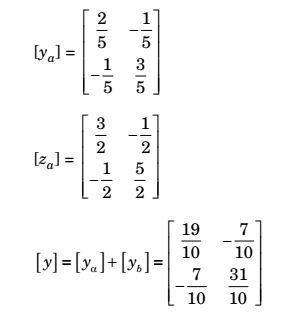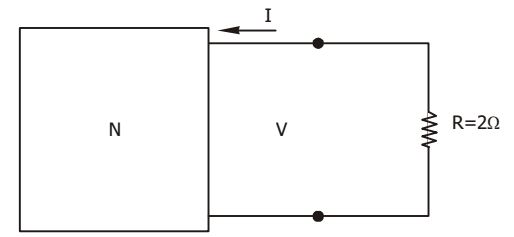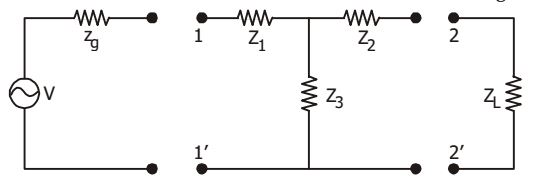Electric circuits miscellaneous
- In respect of the 2-port network shown in the given figure, admittance parameters are :
Y11 = 8 mho, Y12 = Y21 = – 6 mho and Y22 = 6 mho. The values of YA, YB and YC (in units of mho) will be respectively
-
View Hint View Answer Discuss in Forum
From the circuit, I1 = (V1 – V2) YC + V1 .YA
= – V1 (YA + YC) – V2. YC ....(i)
I2 = V1YC + V2 (YB + YC) ...(ii)
YA + YC = Y11 = 8 Ω
YC = Y12 = – Y21 = 6 Ω
YB + YC = Y22 = 6 Ω
∴ YA = 2, YB = 0, YC = 6 ΩCorrect Option: C
From the circuit, I1 = (V1 – V2) YC + V1 .YA
= – V1 (YA + YC) – V2. YC ....(i)
I2 = V1YC + V2 (YB + YC) ...(ii)
YA + YC = Y11 = 8 Ω
YC = Y12 = – Y21 = 6 Ω
YB + YC = Y22 = 6 Ω
∴ YA = 2, YB = 0, YC = 6 Ω
- For the given network, [y] is equal to

-
View Hint View Answer Discuss in Forum

[ za ] = 
3 1 
1 2 
Correct Option: B

[ za ] = 
3 1 
1 2 
- V-I relation for the network shown in the given box is V = 4I – 9. I f now a resistor R = 2 Ω is connected across it, then value of I will be

-
View Hint View Answer Discuss in Forum
V = 4I – 9 = – IR
⇒ 4I – 9 = – 2I
⇒ I = 1.5 ACorrect Option: C
V = 4I – 9 = – IR
⇒ 4I – 9 = – 2I
⇒ I = 1.5 A
- Initially, the circuit shown in the given figure was relaxed. If switch is closed at t = 0, then
values of i(0+), di (0+) and d2i (0+) will respectively be dt dt2 
-
View Hint View Answer Discuss in Forum
By KVL equation
10 = i R + L di + Vc ......(i) dt
At t = 0+, t = 0 and Vc = 0 (short-circuited)
Differentiating equation (i), we have10 = di R + Ld2i + dvc dt dt2 dt ⇒ Ld2i = - di R ...... 
as dVc = i = 0 
dt2 dt dt C ⇒ Ld2i = - 10 × 10 = - 100 dt2 Correct Option: A
By KVL equation
10 = i R + L di + Vc ......(i) dt
At t = 0+, t = 0 and Vc = 0 (short-circuited)
Differentiating equation (i), we have10 = di R + Ld2i + dvc dt dt2 dt ⇒ Ld2i = - di R ...... 
as dVc = i = 0 
dt2 dt dt C ⇒ Ld2i = - 10 × 10 = - 100 dt2
- An impedance match is desired at the 1 – 1 port of the two-port network shown in the given figure. The match will be obtained when zg equals

-
View Hint View Answer Discuss in Forum
Equivalent resistance looking right through terminal 11',
Zeq = (Z2 + ZL)Z3 + Z1 Z2 + Z3 + ZL
For impedance matching,
Zeq= Zg
Correct Option: B
Equivalent resistance looking right through terminal 11',
Zeq = (Z2 + ZL)Z3 + Z1 Z2 + Z3 + ZL
For impedance matching,
Zeq= Zg

